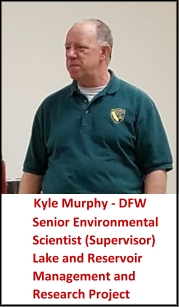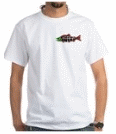 A meeting was held with the Dept. of Fish and Wildlife on Dec. 20, 2016 with Kyle Murphy, Roger Bloom and Kevin Schaffer (new Stafford) and representatives from both kokanee groups. Going forward, this review is expected to be an annual event.
A meeting was held with the Dept. of Fish and Wildlife on Dec. 20, 2016 with Kyle Murphy, Roger Bloom and Kevin Schaffer (new Stafford) and representatives from both kokanee groups. Going forward, this review is expected to be an annual event.
Highlights:
New 2017 Regulations:
2017 Regs (effective March 2017) will allow for 5 trout AND 5 inland salmon daily limits on most lakes (exceptions are the 10 bag limit discussed below). Salmon used to be co-mingled with trout for a total of only 5, now you could take home 5 trout AND 5 salmon (mix of kings or kokanee)
DFW is increasing the daily bag limit for inland salmon to 10 daily and 20 in possession limit at the following lakes ONLY: (For Example at Pardee, you can have 10 kokanee AND 5 trout Daily)
- Pardee
- Bullards Bar
- Bucks
- Trinity (kings included in the inland salmon limit count)
- Scotts Flat
Spawn Assessment Report:
This will be available in February 2017 and will cover the spawning activities in the following lakes:
- Stampede
- Little grass valley
- Bullards Bar
- Bucks
- Pardee
- Boca
- Union valley
- New Melones
- Taylor creek
Berryessa Study:
A study over the past 18 months has been conducted on Lake Berryessa. It is hoped that we could determine why the kokanee fishery has declined there. By using water quality samples from late 2015 and through 2016, it was discovered that the dissolved oxygen content of Lake Berryessa is at a level of 2, a level of 5 is needed for kokanee to thrive. Given the watershed of Lake Berryessa (all rain and no snow) water entering the lake is warmer than lakes that receive their water from snow melt. This is a unique dynamic that Berryessa has that those lakes with snow melt-rivers don’t experience. Speculation is when Berryessa drops somewhere below 60% capacity, the hypolimnium is so small and this has depleted oxygen causing the kokanee to die off. When Berryessa fills, the layer is thicker and the greater oxygen there is available. More work is to be done, but this is good work and is fact based. Kyle is looking at some ways we might change the plant process of kokanee fingerlings, to see if we can improve survival; this includes a barge drop of the fish in deeper water. Final plans are still being determined.
Kokanee Egg Take:
The 2015 egg take resulted in 57,000 eggs gathered from California lakes. All of these fingerlings were planted in Stampede during the spring of 2016. Washington State eggs made up a plant of 500,000 fingerlings which was split between all the other lakes that received kokanee plants in 2016.
The 2016 egg take for California was zero eggs. Approximately 1 million eggs are expected from Washington State January 2017, with an expected plant size of approximately 825,000; these will be planted in the spring of 2017.
DFW is looking at a possible egg take location at Whiskeytown in 2017. Taylor creek is permanently removed from the egg take list due to bears/human potential interaction.
Land Locked Chinook:
All Chinook currently planted in California lakes come from Klamath River and are triploided (except Oroville, which gets its own Feather River Chinook). Actual plant numbers are determined after Klamath River mitigation numbers (Federally Mandated) are met. If there are extra eggs, these are the candidates for planting into other lakes.
The 2016 plant numbers for Chinook was 18,000 in Shasta, 2,200 in Trinity, 1,800 in Whiskeytown. 42,000 Chinook were planted into Folsom Lake.
There will be zero chinook planted into California lakes in 2017, due to a extremely poor return on the Klamath – in fact the Federal mitigation numbers for the river itself were not even met.
To overcome a consistent poor return from the Klamath, the DFG will be moving the triploiding process/equipment to the Feather River hatchery and use Feather River eggs as the source for chinook for inland lakes. There is an abundance of Feather River eggs it is felt that for the foreseeable future it will provide a more consistent and abundant amount of plantable Chinook into our lakes. Due to the complexity of the process and staff training needed to ensure success, there is still work to do, but the DFW hopes to have 2017 ready to go; so Chinook plants will resume for 2107. This is a good step.







